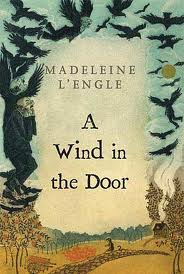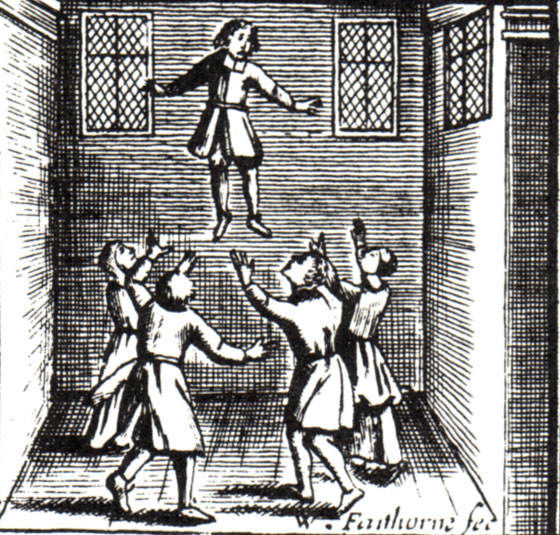Some years after writing The Arm of the Starfish, Madeleine L’Engle decided to write a more direct sequel to her visionary novel, A Wrinkle in Time. Set about a year after the previous adventure, A Wind in the Door is both a larger and smaller book than its predecessor. Larger, because among its themes is the destruction of stars and galaxies, vanished with a terrifying scream; smaller, because a significant part of its storyline focuses on and takes place within a mitochondrion within a human cell. It begins with a quiet conversation about something that might, or might not be, dragons, and ends with a dazzling poetic sequence, a sign of L’Engle’s confidence in her writing powers.
As in the first book, the main protagonist is Meg Murry, still angry and impatient, still inclined to do more than her share of “Why do I have to do this?” but otherwise, thankfully less whiny and better adjusted than in the last book. This is partly thanks to her stronger relationship with Calvin O’Keefe, which has made life easier for her in school and in other ways, and partly, I’d like to think, because of the events of the last book. I have to imagine that, since, oddly enough, aside from two offhand mentions, nobody makes any reference to the previous book at all.
Oddly, because as the book begins, Charles Wallace is in trouble, both physically sick and having problems adjusting in school, and it’s not entirely clear why no one thinks of calling Mrs. Whatsit from the earlier book for assistance. (Even a throwaway line of, “I wish we could call Mrs. Whatsit .” “You know we’ve tried that, and they just don’t answer us” would have been nice.) But their failure does not mean that supernatural entities won’t be contacting them: they are soon joined by Blajeny, a mysterious figure who claims to be a Teacher, and Progo, a cherubim. Charles Wallace initially thinks the cherubim is dragons.
(Sidenote one: was anyone else disappointed on a first read to discover that the visitor wasn’t a dragon after all? I ended up loving Progo—and I cannot see him as anything other than a cherubim—but even now I have to stifle a small sigh of disappointment that they never do find dragons. Sidenote two: Microsoft Word would like you to know that whatever L’Engle might claim, cherubim should be plural, not singular. Moving on.)
Blajeny and Progo are able to explain that the distant screams of dying stars in the cosmos and Charles Wallace’s illness stem from the same cause: Echthroi, creatures who wish to eliminate all existence, and especially the part of existence that insists on singing. (In L’Engle’s vision, this part includes stars and creatures who spend their entire lives inside mitochondria.) The Echthroi and L’Engle, are unconcerned with size: part of the genius of this work is the way it swiftly equates galaxies to humans. After all, humans, Blajeny notes, are galaxies to their parasitic and symbiotic bacteria. This also explains why the Echthroi are attacking stars and the creatures who live inside Charles Wallace’s mitochondria: they don’t attack galaxies; they attack tiny parts of them.
(Was anyone else disappointed to enter biology class and find out that while mitochondria certainly do exist, farandolae not so much?)
In any case, it’s up to Meg, Progo, and Calvin to save Charles Wallace. Once again, Meg needs to learn about and to love, but rather than having to love a good looking, mathematical type, or her kid brother, she must learn to love Mr. Jenkins, her former principal. (No, not that sort of love. The nice platonic sort of love that will prevent Mr. Jenkins from getting eaten by Echthroi.) Mr. Jenkins, a somewhat well meaning and slightly annoying character from the first book is transformed here into a considerably less well meaning and highly annoying character. Not surprisingly, Meg finds him almost impossible to love—a sentiment most readers will share.
Like its predecessor, A Wind in the Door straddles the line between fantasy and science fiction. On the one hand, the book deals with traditionally scientific and biological concepts of mitochondria and oxygen transfers; on the other hand, the book also allows its characters to shift sizes without thought (thought, they are told, is limiting) and take journeys into the fantastic, into places that cannot be travelled. And it touches on the fears of a 1970s world: its characters are worried about overpopulation, pollution and the steady growth of unreason in a world they wish were reasonable.
The book also continues L’Engle’s tendency to bring in her characters from other novels in cameo appearances; the two physicists Dr. Murry consults with just happen to be the two physicists from The Young Unicorns. (If you remember, the Austins mentioned tessering and the Murrys in The Moon by Night.) And, less fortunately, it brings back L’Engle’s fondness for the verb “moan,” something that would become considerably more important and aggravating in later books.
More importantly, A Wind in the Door also introduces kything, L’Engle’s term for something between telepathy and empathy, where beings can share thoughts and awareness, often across vast distances—and, in later books, time. (For years, I thought L’Engle completely made the word up, and was startled to encounter it in Chaucer, with admittedly a somewhat different meaning. There and in Scots English, it means “to manifest, show, or appear,” the way her characters can show one another their innermost selves.) L’Engle was to be fond enough of the concept to bring it back in later books; she would also bring back the Echthroi.
And like its predecessor, it’s not flawless. Charles Wallace becomes even more of a plot point than a character here. Blajeny calls Charles Wallace into his classroom presumably to teach him to adapt and get along in school, but after bringing a snake to his regular classroom (I’m in agreement that this is an excellent move), Charles Wallace more or less completely disappears from the book except when needed to remind everyone else just how urgent their mission to heal him is. With the exception of Mr. Jenkins, everyone is just a little too calm with sudden appearances and disappearances, and you would think everyone at the end would be just a little more interested in what happened. (A partial explanation for this is introduced in the next book of this series.)
And yet, such is the speed and poetic power of this book that the flaws are nearly unnoticeable on a first or even a second read. This is L’Engle at the height of her poetic powers, and the failure of this book to receive the same attention and fame as its predecessor is a genuine shame.
Mari Ness wouldn’t mind travelling to another galaxy to be in someone else’s thought, as long as that thought included coffee. She lives in central Florida.














